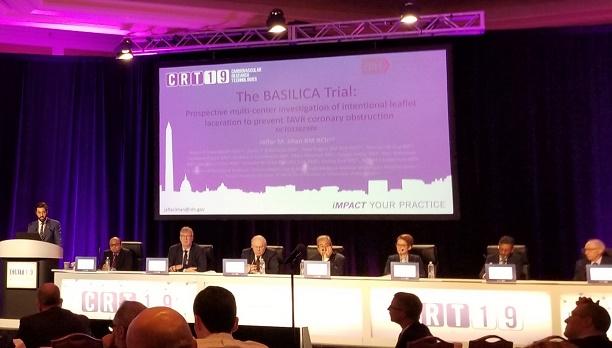BASILICA Leaflet Laceration Before TAVR Helps Prevent Coronary Obstruction
Intended for high-risk patients, the technique uses focused radiofrequency to tear the leaflet so that coronary flow is not impeded by TAVR devices.

WASHINGTON, DC—Early feasibility data are showing high success with a novel procedure called BASILICA, which lacerates the preexisting aortic leaflet (native or failed prosthetic) immediately before TAVR in patients at high risk for coronary obstruction.
BASILICA uses focused radiofrequency directed by catheters and guidewires to split the aortic leaflet before TAVR is performed—similar to the LAMPOON procedure—and this allows for maintained flow after the valve is in place. As previously reported by TCTMD, the procedure was successful in seven patients tested in compassionate use circumstances, with no evidence of coronary obstruction at 30 days.
Jaffar M. Khan, BM, BCh (MedStar Washington Hospital Center, Washington, DC), who presented results from the 30-patient BASILICA IDE trial today in a late-breaking clinical trial session at CRT 2019, told TCTMD that the future of the procedure will depend on optimal patient selection and improvement in methods of predicting risk of coronary obstruction. Currently, the risk of coronary obstruction following TAVR is estimated to be about 1%, he reported.
“To get better at predicting coronary obstruction risk, we need high-quality CTs in a large registry to improve our prediction models for this,” Khan said. “In the meantime, there’s a large grey zone . . . where you're uncertain whether there's coronary obstruction, [and] physicians are likely to perform BASILICA if they think it’s safe and feasible rather than risk quite a devastating complication.”
Procedural Success, No Obstructions
Findings from the trial show that successful BASILICA traversal and laceration was observed in 93% of patients and 95% of leaflets. All patients survived their procedure and had successful TAVR. At 30 days, one patient died of cardiovascular causes, three patients had a stroke (one was disabling), two had life-threatening bleeding unrelated to the procedure, one had an MI, and six had major vascular complications also unrelated to BASILICA. No patients reported coronary artery obstruction at 30 days, and none required a repeat procedure for valve-related dysfunction. In the 13 procedures for which cerebral protection was used, embolic debris was captured in 46%.
Hemodynamic instability was uncommon after BASILICA, occurring at a rate of 7%, and it resolved promptly following TAVR, Khan reported. Overall, 11% of patients developed hypoattenuating leaflet thickening (HALT) on follow-up CT, while 4% developed hypoattenuation affecting motion (HAM).
Overall, 43% of procedures in the study were in native valves and the rest were in bioprosthetic valves, 80% of the patients were female, and 23% had a prior stroke. Alternative access was used in 23%, and 10% underwent their procedure under conscious sedation.
The procedure has several limitations, Khan said. The guidewire traversal not only requires a calcium-free target, but BASILICA “requires careful procedure planning,” he explained.
Cerebral Protection, Measurement Data
In discussion following the presentation, co-moderator Jeffrey Popma, MD (Beth Israel Deaconess Medical Center, Boston, MA), said he was impressed with the stroke rate observed in the study, but suggested that cerebral protection “might be useful” during BASILICA procedures. “Do you plan on using cerebral protection until we sort out whether this is just confounding factors of the patients’ baseline morbidities or is actually something that's related to the procedure?” he asked.
Additionally, Popma noted that TAVR operators are great at analyzing CTs in native annuli, but now “it seems as if there needs to be a very unique lexicon for evaluating surgical valve failures and TAVR valve failures with respect to the measurements you have made. Are those out there anywhere? How do we, when we’re planning a case, get access to the kind of thinking process that you do in thinking about how to proceed?”
Khan said that the data are available but not standardized. Measuring the valve-to-coronary ostium distance (VTC) is a starting point, and operators also need to be aware of sinotubular junction (STJ) obstruction, he said.
Yael L. Maxwell is Senior Medical Journalist for TCTMD and Section Editor of TCTMD's Fellows Forum. She served as the inaugural…
Read Full BioSources
Khan JM. The BASILICA trial: prospective multi-center investigation of intentional leaflet laceration to prevent TAVR coronary obstruction. Presented at: CRT 2019. March 4, 2019. Washington, DC.
Disclosures
- Khan reports being an inventor on patents assigned to the NIH on catheter devices to lacerate valve leaflets.


Comments